Crack Initiation in Compacted Graphite Iron with Random Microstructure: Effect of Volume Fraction and Distribution of Particles
Abstract
1. Introduction
2. Methodology
2.1. Model Geometry and Boundary Conditions
- (i)
- The centroid coordinates of each particle () are derived from the results table of ImageJ.
- (ii)
- The distance between a pair of particles and is calculated as
2.2. Statistical Validation of Graphite Particle Orientation
2.3. Constitutive Relations
2.4. Convergence Study and Model Validation
3. Results and Discussion
3.1. Effect of Volume Fraction and Nodularity
3.2. Effect of Graphite Particle Spacing
3.3. Effect of Graphite Particle Orientation
4. Conclusions
- The present approach effectively captures the mechanical and fracture behaviours of CGI, as evidenced by the comparison of the crack path and effective stress–strain curves between the experimental data and numerical results.
- The macroscopic Young’s modulus of CGI increased with the increase in the nodularity and the volume fraction of graphite particles.
- Crack initiation strain demonstrated a complex dependency on the aspect ratio, orientation, and distribution of graphite inclusions, with the particle size playing a significant role. Accounting for the size of the graphite particles helps us to understand the damage and fracture mechanisms of CGI.
Author Contributions
Funding
Informed Consent Statement
Data Availability Statement
Conflicts of Interest
Appendix A. Effect of Graphite Particle Orientation

References
- König, M. Literature review of microstructure formation in compacted graphite Iron. Int. J. Cast Met. Res. 2010, 23, 185–192. [Google Scholar] [CrossRef]
- Cao, M.; Baxevanakis, K.P.; Silberschmidt, V.V. High-temperature behaviour and interfacial damage of CGI: 3D numerical modelling. Multiscale Multidiscip. Model. Exp. Des. 2023. [Google Scholar] [CrossRef]
- Li, J.; Wang, P.; Cui, X.; Li, K.; Yi, R. Gray cast iron cylinder head thermal mechanical fatigue analysis. In Proceedings of the FISITA 2012 World Automotive Congress, Beijing, China, 27–30 November 2012; Springer: Berlin/Heidelberg, Germany, 2013; pp. 243–257. [Google Scholar]
- Zhang, Y.; Pang, J.; Shen, R.; Qiu, Y.; Li, S.; Zhang, Z. Investigation on tensile deformation behavior of compacted graphite iron based on cohesive damage model. Mater. Sci. Eng. A 2018, 713, 260–268. [Google Scholar] [CrossRef]
- Liu, Y.; Li, Y.; Xing, J.; Wang, S.; Zheng, B.; Tao, D.; Li, W. Effect of graphite morphology on the tensile strength and thermal conductivity of cast iron. Mater. Charact. 2018, 144, 155–165. [Google Scholar] [CrossRef]
- Mohammed, W.M.; Ng, E.; Elbestawi, M.A. Modeling the effect of the microstructure of compacted graphite iron on chip formation. Int. J. Mach. Tools Manuf. 2011, 51, 753–765. [Google Scholar] [CrossRef]
- Luo, X.; Baxevanakis, K.P.; Silberschmidt, V. V Microstructure-based CZE model for crack initiation and growth in CGI: Effects of graphite-particle morphology and spacing. Solids 2024, 5, 123–139. [Google Scholar] [CrossRef]
- Hieber, A.F. Fracture in compacted graphite iron. AFS Trans. 1978, 86, 143–154. [Google Scholar]
- Lopez-Covaleda, E.A.; Ghodrat, S.; Kestens, L.A.I. Semi in-situ observation of crack initiation in compacted graphite iron during thermo mechanical fatigue. Int. J. Fatigue 2020, 137, 105648. [Google Scholar] [CrossRef]
- Yang, H.W.; Wang, X.M.; Liu, W.; Huang, W.; Wu, M.; Xue, M.L.; Li, L. Influence of distribution and size of graphite particle on the machinability of nodular cast iron. Eng. Fract. Mech. 2024, 297, 109882. [Google Scholar] [CrossRef]
- Gregorutti, R.W.; Grau, J.E. Mechanical properties of compacted graphite cast iron with different microstructures. Int. J. Cast Met. Res. 2014, 27, 275–281. [Google Scholar] [CrossRef]
- Hollister, S.J.; Kikuchi, N. Homogenization theory and digital imaging: A basis for studying the mechanics and design principles of bone tissue. Biotechnol. Bioeng. 1994, 43, 586–596. [Google Scholar] [CrossRef] [PubMed]
- Okereke, M.; Keates, S. Boundary Conditions. In Finite Element Applications: A Practical Guide to the FEM Process; Okereke, M., Keates, S., Eds.; Springer International Publishing: Cham, Switzerland, 2018; pp. 243–297. ISBN 978-3-319-67125-3. [Google Scholar]
- Luo, X.; Baxevanakis, K.P.; Silberschmidt, V.V. Tensile deformation of compacted graphite iron with realistic microstructures: Effect of morphology of graphite inclusions. In Computational and Experimental Simulations in Engineering; Li, S., Ed.; Springer Nature: Cham, Switzerland, 2024; pp. 721–730. [Google Scholar]
- Andriollo, T.; Thorborg, J.; Tiedje, N.S.; Hattel, J. Modeling of damage in ductile cast iron—The effect of including plasticity in the graphite nodules. IOP Conf. Ser. Mater. Sci. Eng. 2015, 84, 012027. [Google Scholar] [CrossRef]
- Andriollo, T.; Thorborg, J.; Tiedje, N.; Hattel, J. A micro-mechanical analysis of thermo-elastic properties and local residual stresses in ductile iron based on a new anisotropic model for the graphite nodules. Model. Simul. Mater. Sci. Eng. 2016, 24, 055012. [Google Scholar] [CrossRef]
- Mohammed, W.M.; Ng, E.G.; Elbestawi, M.A. On stress propagation and fracture in compacted graphite iron. Int. J. Adv. Manuf. Technol. 2011, 56, 233–244. [Google Scholar] [CrossRef]
- Palkanoglou, E.N.; Baxevanakis, K.P.; Silberschmidt, V.V. Thermal debonding in compacted graphite iron: Effect of interaction of graphite inclusions. Procedia Struct. Integr. 2021, 37, 209–216. [Google Scholar] [CrossRef]
- Gad, S.I.; Attia, M.A.; Hassan, M.A.; El-Shafei, A.G. Predictive computational model for damage behavior of metal-matrix composites emphasizing the effect of particle size and volume fraction. Materials 2021, 14, 2143. [Google Scholar] [CrossRef] [PubMed]
- Naghdinasab, M.; Farrokhabadi, A.; Madadi, H. A numerical method to evaluate the material properties degradation in composite RVEs due to fiber-matrix debonding and induced matrix cracking. Finite Elem. Anal. Des. 2018, 146, 84–95. [Google Scholar] [CrossRef]
- Niu, J.; Huang, C.; Shi, Z.; Liu, H.; Tang, Z.; Su, R.; Chen, Z.; Li, B.; Wang, Z.; Xu, L. A chip formation mechanism taking into account microstructure evolution during cutting process: Taking compacted graphite iron machining as an example. Int. J. Mach. Tools Manuf. 2024, 198, 104150. [Google Scholar] [CrossRef]
- Yang, W.J.; Pang, J.; Wang, L.; Wang, S.G.; Zhang, Z.F. Tensile properties and damage mechanisms of compacted graphite iron based on microstructural simulation. Mater. Sci. Eng. A 2021, 814, 141244. [Google Scholar] [CrossRef]
- Zhang, Y.Y.; Shen, R.L.; Li, M.Z.; Pang, J.C.; Zhang, Z.F. Mechanical damage behavior of metal matrix composites with the arbitrary morphology of particles. J. Mater. Res. Technol. 2020, 9, 7002–7012. [Google Scholar] [CrossRef]
- He, Y.; Zhang, J.; Qi, Y.; Liu, H.; Memon, A.R.; Zhao, W. Numerical study of microstructural effects on chip formation in high speed cutting of ductile iron with discrete element method. J. Mater. Process. Technol. 2017, 249, 291–301. [Google Scholar] [CrossRef]
- Palkanoglou, E.N.; Baxevanakis, K.P.; Silberschmidt, V.V. Thermal debonding of inclusions in compacted graphite iron: Effect of matrix phases. Eng. Fail. Anal. 2022, 139, 106476. [Google Scholar] [CrossRef]
- Haeri, M.; Haeri, M. ImageJ Plugin for Analysis of Porous Scaffolds used in Tissue Engineering. J. Open Res. Softw. 2015, 3, 2–5. [Google Scholar] [CrossRef]
- Johnson, G.R.; Cook, W.H. A constitutive model and data for metals subjected to large strains, high strain rates and high temperatures. In Proceedings of the 7th International Symposium on Ballistics, The Hague, The Netherlands, 19–21 April 1983. [Google Scholar]
- Mohammed, W.M.; Ng, E.; Elbestawi, M.A. Modeling the effect of compacted graphite iron microstructure on cutting forces and tool wear. CIRP J. Manuf. Sci. Technol. 2012, 5, 87–101. [Google Scholar] [CrossRef]
- Razanica, S.; Josefson, L.B.; Larsson, R.; Sjögren, T. Validation of the ductile fracture modeling of CGI at quasi-static loading conditions. Int. J. Damage Mech. 2021, 30, 1400–1422. [Google Scholar] [CrossRef]
- Greenstreet, W.L.; Yahr, G.T.; Valachovic, R.S. The behavior of graphite under biaxial tension. Carbon 1969, 11, 43–57. [Google Scholar] [CrossRef]
- Joshi, A.; Baxevanakis, K.P.; Silberschmidt, V.V. High-temperature creep of cast irons. Adv. Struct. Mater. 2023, 185, 147–173. [Google Scholar] [CrossRef]

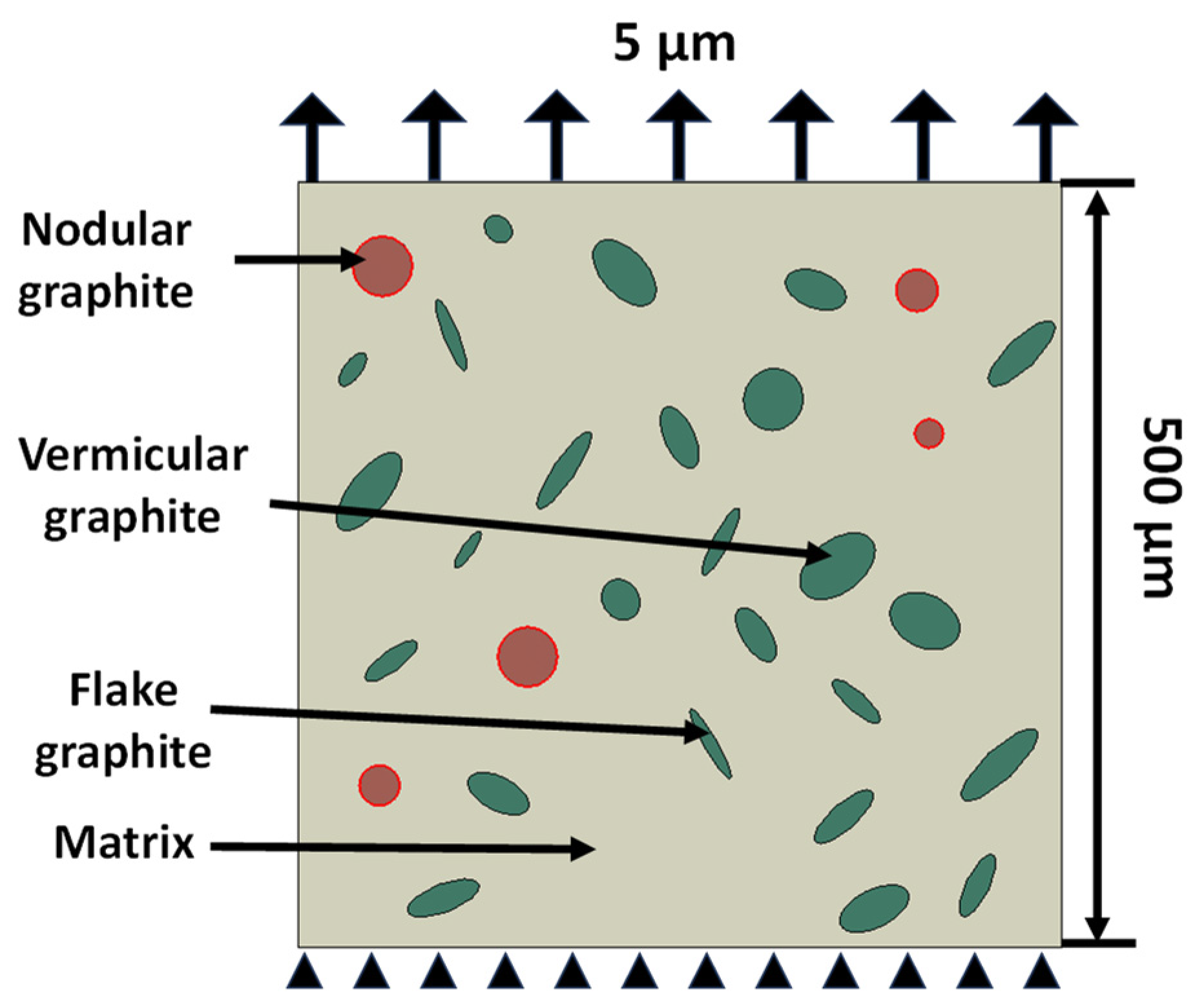

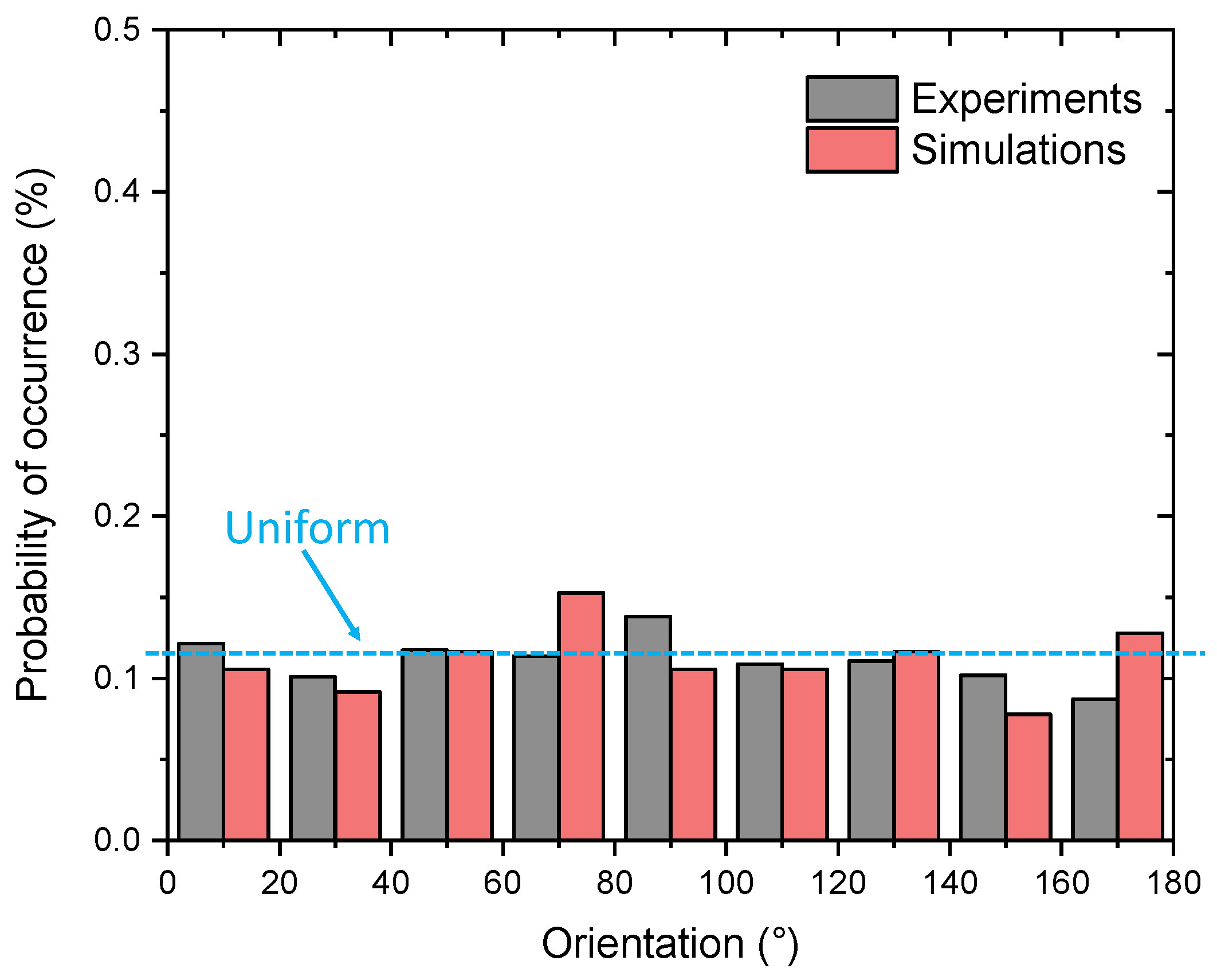
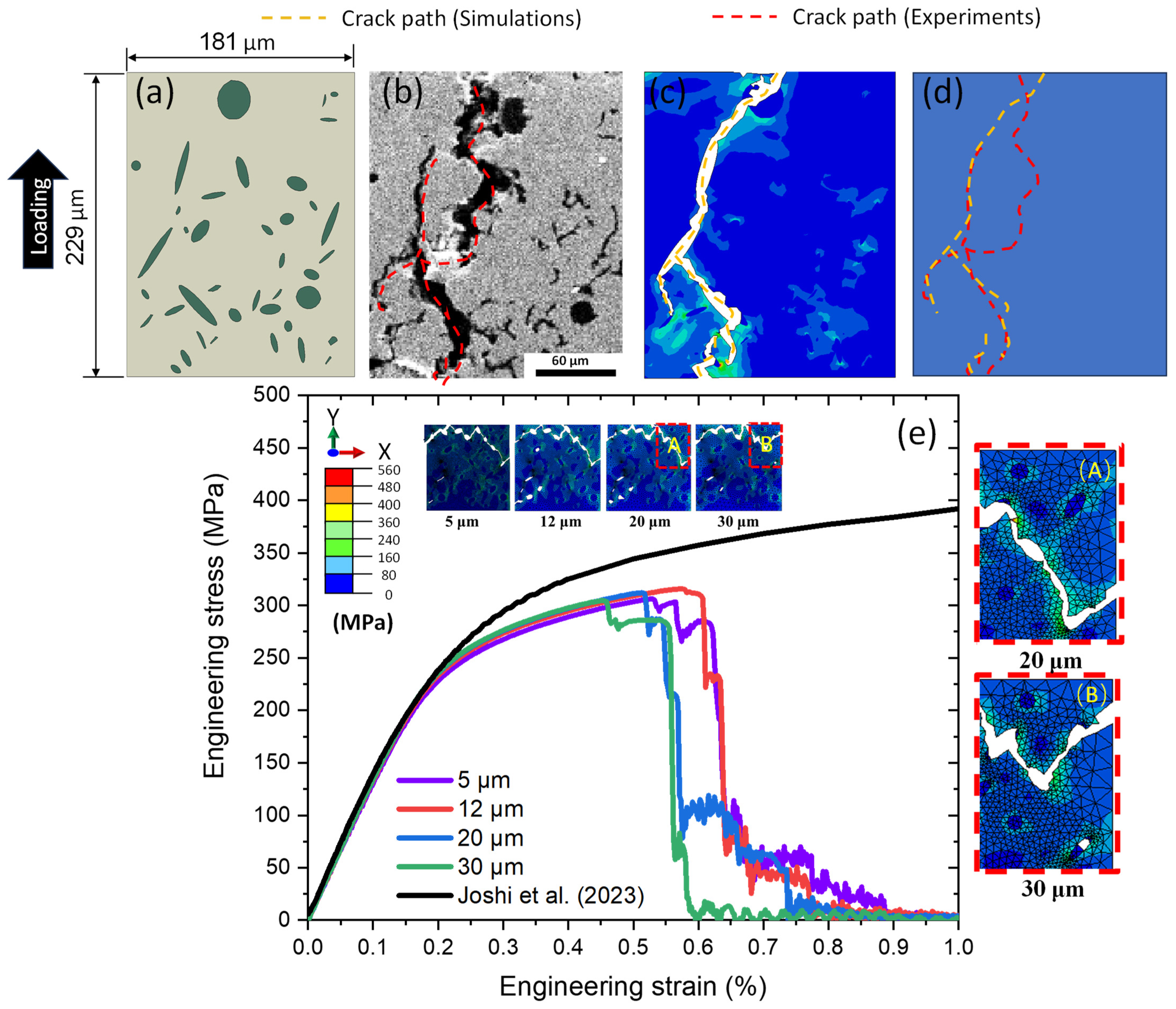
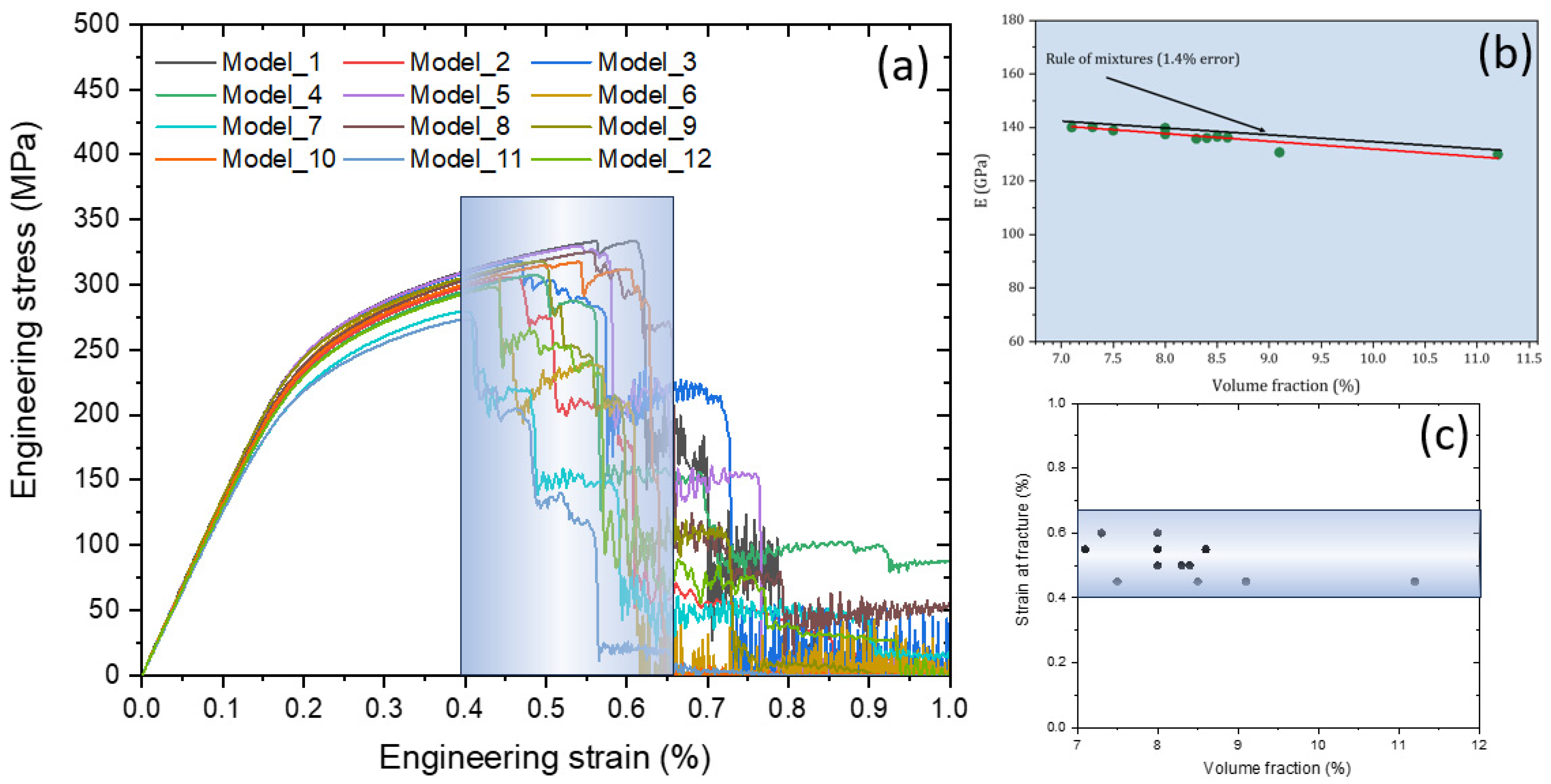
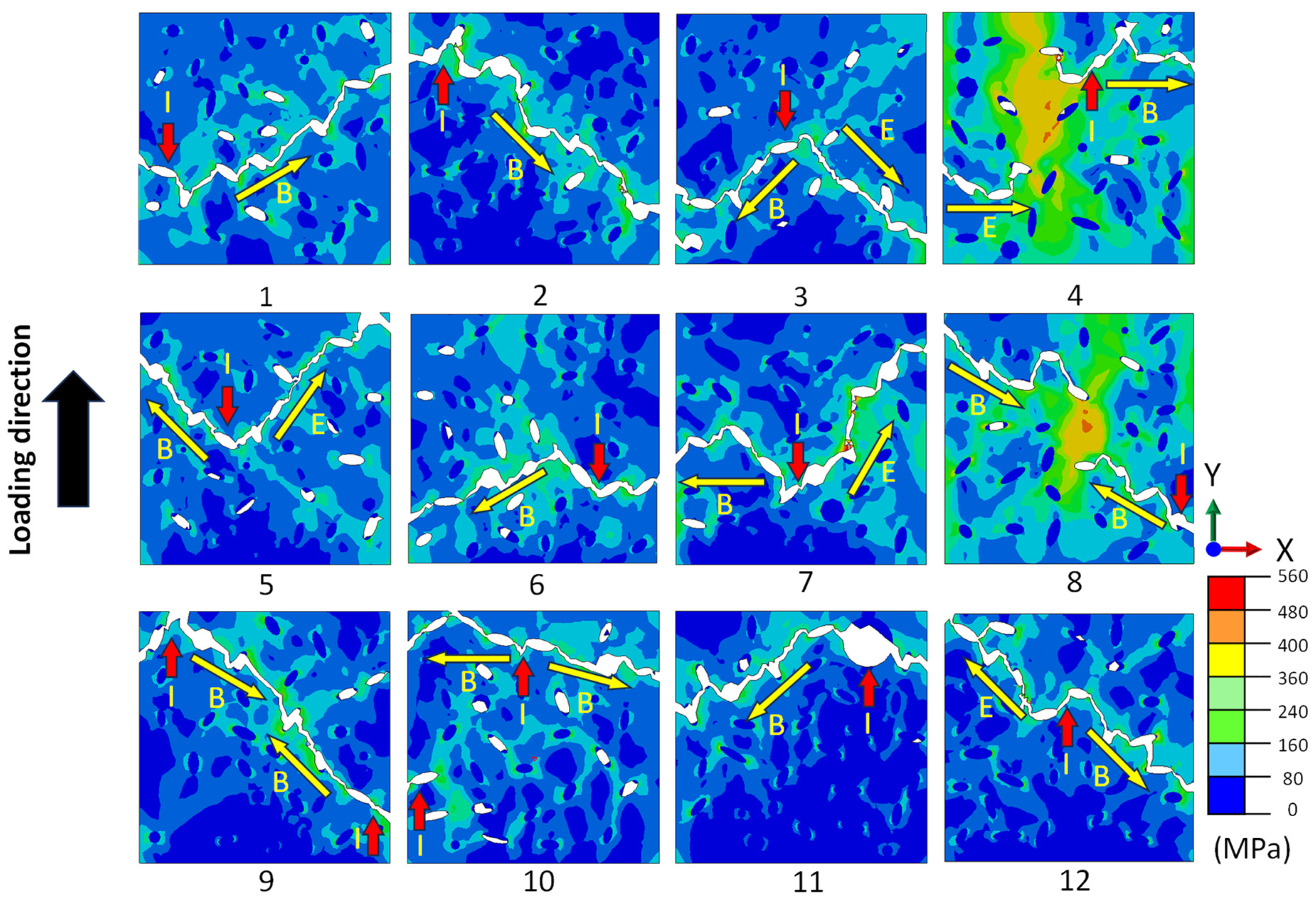
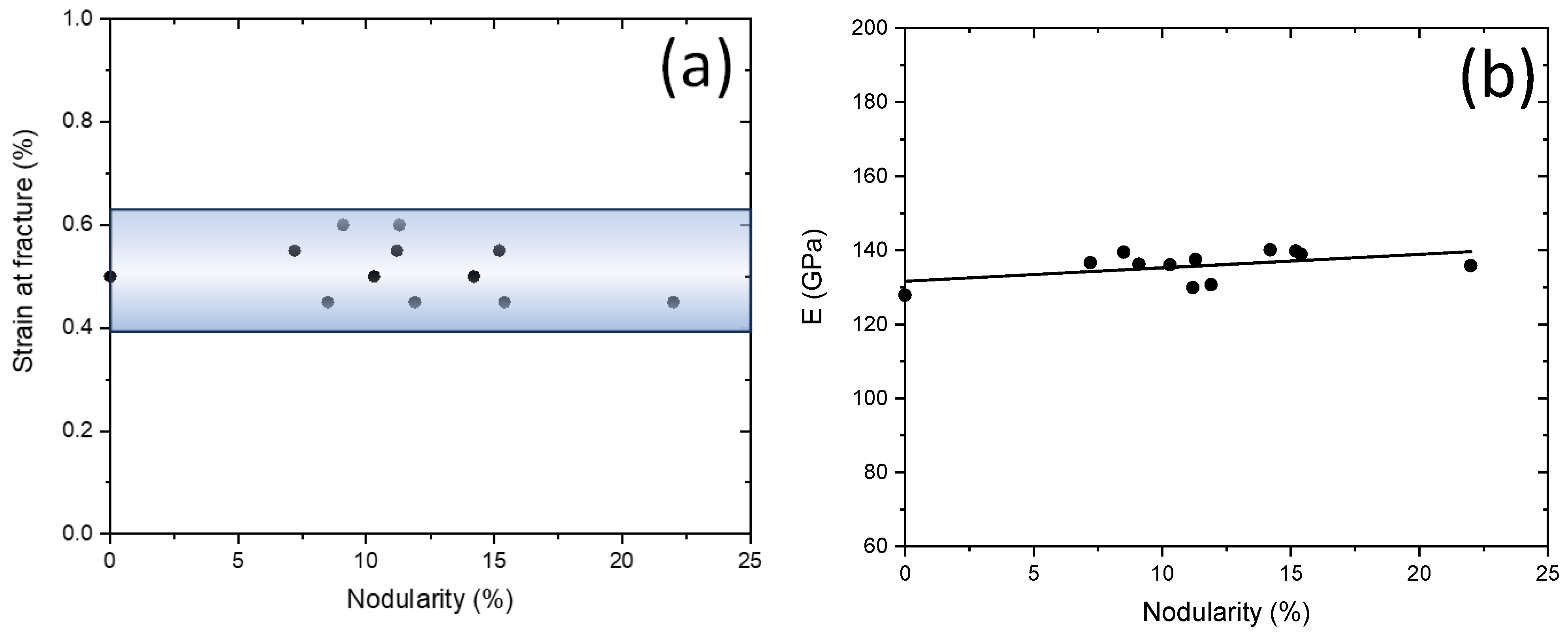

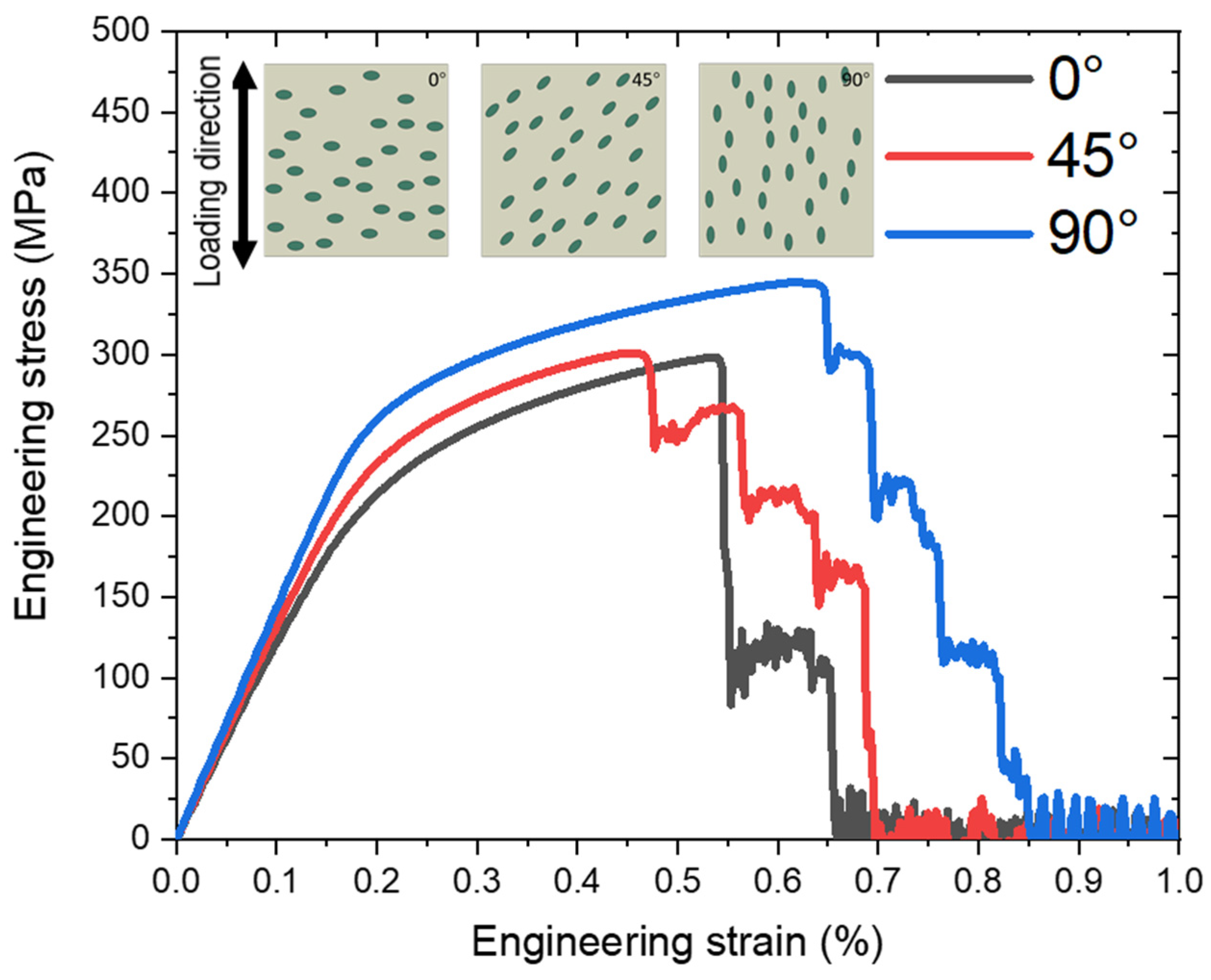

| Fe | C | Si | Cu | Mn | Sn |
| 92 | 3.8 | 2.42 | 0.917 | 0.297 | 0.083 |
| Cr | Ni | S | P | Ce | Mg |
| 0.025 | 0.023 | 0.013 | 0.01 | 0.01 | 0.009 |
| Al | Ti | V | Mo | Nb | |
| 0.008 | 0.009 | 0.008 | 0.001 | 0.002 |
| Graphite Fraction (%) | Perimeter (μm) | Area (μm2) | |
|---|---|---|---|
| Experiments [18] | 5.2–11.37 | 3.54–315.88 | 0.99–6086.96 |
| Simulations | 7.1–11.2% | 31.4–263.76 | 78.5–5538.96 |
| Software | Analysis Type | Domain Length | Graphite (%) | Mesh Size | Element Type | Loading |
|---|---|---|---|---|---|---|
| Abaqus (2021) | Dynamic explicit | 0.5 mm | 7.1–11.2% | 20 µm | Triangular CPE3 | Tensile |
| E (GPa) | ν (–) | A (MPa) | B (MPa) | n | d1 | d2 | d3 |
|---|---|---|---|---|---|---|---|
| 152.5 | 0.26 | 260 | 1010 | 0.467 | 0.0133 | 0.0645 | 8.057 |
| Mass Density (tonne/mm³) | Young’s Modulus (GPa) | Poisson’s Ratio |
|---|---|---|
| 2.26 × 10−9 | 15.85 | 0.2 |
| Plastic strain | Stress (MPa) | |
| 0 | 27.56 | |
| 0.000512 | 27.62 | |
| 0.00102 | 27.76 | |
| 0.00205 | 28.32 | |
| 0.00307 | 29.25 | |
| 0.00409 | 30.53 | |
| 0.00512 | 32.17 | |
| 0.00614 | 34.18 | |
| Average distance from four neighbours (μm) | |
| Nearest neighbour distance (μm) | |
| Average distance from four neighbours/normalised with major axis of particle | |
| Nearest neighbour distance/normalised with major axis of particle |
Disclaimer/Publisher’s Note: The statements, opinions and data contained in all publications are solely those of the individual author(s) and contributor(s) and not of MDPI and/or the editor(s). MDPI and/or the editor(s) disclaim responsibility for any injury to people or property resulting from any ideas, methods, instructions or products referred to in the content. |
© 2024 by the authors. Licensee MDPI, Basel, Switzerland. This article is an open access article distributed under the terms and conditions of the Creative Commons Attribution (CC BY) license (https://creativecommons.org/licenses/by/4.0/).
Share and Cite
Luo, X.; Baxevanakis, K.P.; Silberschmidt, V.V. Crack Initiation in Compacted Graphite Iron with Random Microstructure: Effect of Volume Fraction and Distribution of Particles. Materials 2024, 17, 3346. https://doi.org/10.3390/ma17133346
Luo X, Baxevanakis KP, Silberschmidt VV. Crack Initiation in Compacted Graphite Iron with Random Microstructure: Effect of Volume Fraction and Distribution of Particles. Materials. 2024; 17(13):3346. https://doi.org/10.3390/ma17133346
Chicago/Turabian StyleLuo, Xingling, Konstantinos P. Baxevanakis, and Vadim V. Silberschmidt. 2024. "Crack Initiation in Compacted Graphite Iron with Random Microstructure: Effect of Volume Fraction and Distribution of Particles" Materials 17, no. 13: 3346. https://doi.org/10.3390/ma17133346
APA StyleLuo, X., Baxevanakis, K. P., & Silberschmidt, V. V. (2024). Crack Initiation in Compacted Graphite Iron with Random Microstructure: Effect of Volume Fraction and Distribution of Particles. Materials, 17(13), 3346. https://doi.org/10.3390/ma17133346












